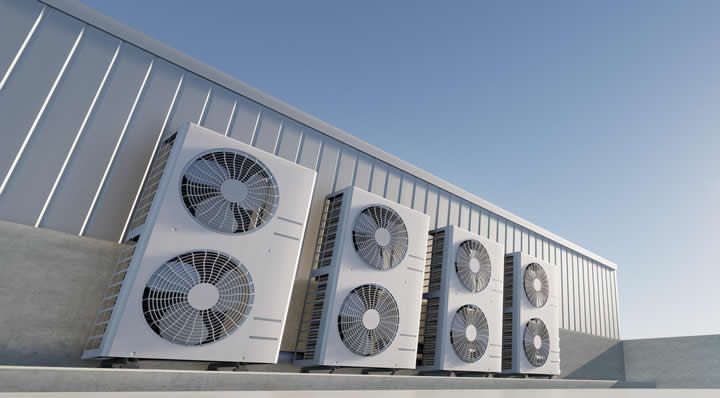Faced with fluctuating energy prices and increasingly stringent environmental regulations, countless industries are searching for more sustainable and energy-efficient technologies. HVAC is no exception to this trend
 Delivering HVAC efficiency with permanent magnet motors
Delivering HVAC efficiency with permanent magnet motors

Article from | Nidec Drives
Faced with fluctuating energy prices and increasingly stringent environmental regulations, countless industries are searching for more sustainable and energy-efficient technologies. HVAC is no exception to this trend but has one key advantage over many other sectors – it already has access to a powerful, energy-efficient technology in the form of permanent magnet (PM) motors paired with variable frequency drives (VFDs).
One of the key drivers behind the rising demand for energy efficient technologies lies in the ever-expanding regulatory standards aimed at enhancing building energy efficiency, such as California’s Title 24 Building Code. Among many other things, the code has stringent requirements for HVAC systems, mandating the use of fans that can operate at multiple speeds. This allows systems to adjust their output based on actual need rather than running at full capacity continuously.
This regulation is stricter than most, but reflects a broader shift towards energy conservation. It is indicative of similar trends observed globally, such as Europe's eco-design regulations which impose minimum efficiency standards for motor and drive systems. As more and more of these international mandates come into force, they are fundamentally shifting the way HVAC systems are designed, operated, and maintained worldwide, putting greater emphasis on powerful energy-saving technologies.
VFDs and PM motors
One of the key elements in meeting these regulations is the use of VFDs, which play a crucial role in enhancing the operational efficiency of HVAC systems by optimising the performance of components such as supply fans, compressors, and pumps.
When it comes to fans, for example, VFDs can control the airflow to match specific heating or cooling needs. For compressors, they can adjust cooling capacity to accommodate varying thermal loads, ensuring efficient energy use and maintaining ideal indoor climates even in fluctuating conditions. Similarly, in hydronic systems, VFDs fine-tune pump flow rates based on real-time demands, enhancing system efficiency and contributing to significant energy savings.
By integrating VFDs, HVAC systems operate more efficiently, cost-effectively, and reliably, aligning with modern environmental and energy standards, and this only improves when they also make use of PM motors.
Traditional induction motors work by a proportion of the power supplied to the motor creating a magnetic field to provide torque to make the motor turn. PM motors use permanent magnets on the rotor to create a permanent magnetic field, therefore saving the energy that goes into this task in an induction machine. This means they are able to offer high efficiency and exceptional performance across a variety of speeds and loads, which, when paired with the enhanced control offered by VFDs, results in a synergy that greatly enhances overall system efficiency thanks to the ‘affinity laws’.

An affinity for efficiency
The affinity laws are fluid dynamics principles that describe how changes in the speed of a pump or fan impact flow rate, pressure, and power usage. Specifically, the flow rate of fluid is directly proportional to the speed of the device, while the pressure or head created increases with the square of the speed. Most significantly, the power consumption is proportional to the cube of the speed ratio - rising exponentially.
This exponential relationship means that even modest reductions in speed can result in substantial decreases in power usage. For instance, reducing the speed of a fan by just 20% can lead to a reduction in power consumption of nearly 50%.
In HVAC systems, the ability to precisely control speed by combining VFDs and PM motors allows operators to fully exploit the potential of the affinity laws. This tailored approach not only optimises energy use but also enhances the overall efficiency and longevity of the system, leading to cost savings and a reduced environmental footprint.
A rising technology
The potential offered by PM motors has been known for decades, but traditionally they have been an expensive choice due to comparatively higher costs and the need for speed feedback devices (also known as encoders) for effective control. Now, with advances to motor control algorithms, the VFD can control the PM motor without the encoder, reducing costs.
As the costs associated with manufacturing and implementing PM motor technology continue to decline, these motors are becoming a more feasible option for widespread use across the HVAC industry.
Importantly, this reduction in cost does not compromise on quality or efficiency but rather makes it accessible for a broader range of applications, promoting the adoption of greener technologies. The affordability, paired with superior performance characteristics, makes PM motors an increasingly attractive choice for modern HVAC systems.
This shift not only supports global energy conservation goals but also aligns with the economic interests of businesses and consumers seeking to reduce energy costs and enhance system reliability.
Nidec Drives
We create the world’s motion.
We provide electric drive solutions that add value to our world, from the production of food, movement of materials and people, to keeping us comfortable in any environment.
Our precision engineered drives are designed to improve performance, efficiency, and productivity, creating essential motion towards a sustainable future.
Together, we make the world spin smarter.
For more information, visit www.ControlTechniques.com
The content & opinions in this article are the author’s and do not necessarily represent the views of AltEnergyMag
Comments (0)
This post does not have any comments. Be the first to leave a comment below.
Featured Product

